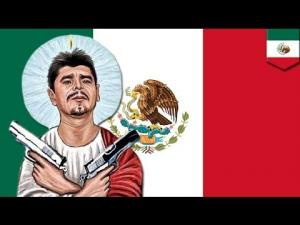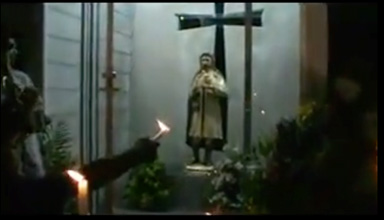The Knights Templar Narcotheology: Deciphering the Occult of a Narcocult
Kate Kingsbury

Popularized Image of San Nazario Holding Two-Crossed Pistols with Mexican Flag
Note: An abbreviated version of this article appeared as Deciphering the Narcotheology of the Knights Templar Mexican Narcocult at Patheos on 13 October 2018. It has been written specifically for Small Wars Journal—El Centro as part of an ongoing Los Caballeros Templarios de Michoacán research project that will be published as a future eBook.
Latin America is the most Catholic region on earth and as such religion, unlike in much of the secularised West continues to play a primordial part for the large majority of its inhabitants. Indeed, religion is a coping strategy for negotiating the many difficulties encountered daily. Saints and folk saints have long had a central role in the religious landscape of Latin America. Although God may be too abstract or appear too distant for some to supplicate, folk saints, especially those based on local personages who met their demise, often in a dramatic fashion, lend an intimacy and familiarity to faith for local people.
In recent years we have also witnessed Evangelical movements pushing to the forefront of the Christian landscape, with Protestant Pentecostal movements drawing in crowds in Brazil and Chile to a large extent, but also increasingly in Mexico. Alongside religious movements, in the post-Cold War landscape, there remain vestiges of guerrilla groups who obtained weaponry, training and political support for decades from the Soviet bloc. One of the most notorious of these is the withering People’s Revolutionary Army, the EPR, an insurgent movement with an ideology that espouses an alternative system to what they believe is an ineffectual Mexican state. The Knights Templar, as I will describe, have created a new pseudo-religion from the bricolage of these regional religious elements, synthesised to spiritually sanction their activities. Moreover, their theology imbues them with a sense of omnipotence and the ability to influence others, as their doctrine presents the narcocult as possessing secret powers with which they wield supernatural forces, but also represents their ideology as an alternative mode of governance, contradistinct to that of the supposedly otiose Mexican state. As I will evince, this had a particularly powerful force amongst disenfranchised and disillusioned youth seeking new means of navigating the precarity of life in the Mexican post-colony. These young men familiar with and impelled by all the religious ingredients amalgamated within this syncretic narcocult, were easy to proselytise and utilise as minions to further the ambitions of the leaders.
Although they may at first blush appear incongruous, criminal organizations have long adhered to religious worship and ritual in annex to their nefarious activities. In Latin America, many renowned drug lords have affiliated themselves with official Catholic saints, as well as with folk saints to spiritually sanction their activities. Their devotional activities give narcos the impression of wielding supernatural forces with which to arm and protect themselves in a world characterised by extreme violence and daily uncertainty. Santa Muerte, for example, the sanctification of death, allows narcos to confront death head on, whilst devotees also believe they can harness her powers to bring death to their enemies.
Anthropologists theorize that since time immemorial humans have turned to religion to explain, predict and control elements within their lives. Explanations include a reason, for example, for being on the planet, or for accounting for misfortunes. For example, perhaps one did not pray enough, or make apposite offerings to one’s folk saint. Spiritual explanations create order where the reality of chaos reigns. Drug dealers, like other devotees seek succor in such a spiritual system. Narcos have turned to religion not only to explicate their situation and sanction their inimical activities, but due to their precarious lifestyles they have a particular penchant for seeking to control events, and people, through supernatural forces. This frequently manifests as a desire to protect themselves from the many hazards that their profession entails. Pablo Escobar accredited his extraordinary escape from the attack of the rival Cartel of Cali to Divino Niño and the Holy Infant of Atocha whom he was a devotee of. Many Mexican narcos worship the Santo Niño de Atocha. Although the tradition originated in Spain the only remaining statue is now located in Zacatecas, Mexico. The Santo Niño is the patron of those unjustly imprisoned, travellers and people in danger. Narcos deem themselves all of the above. Some of the members of Escobar’s cartel were devout worshippers of St. Jude. In Mexico, St. Jude has been ubiquitously supplicated for protection by drug cartel members. Jesus Malverde is another popular folk saint amongst drug traffickers and is known as a narcosaint. Although he did not traffic drugs, Malverde who hailed from Sinaloa, did rob and kill. He was eventually hung in the 1900s for his crimes. Malverde is believed to work miracles by those who worship him.
Given this religious context, it is no surprise that a new folk Saint emerged amongst the Knights Templar: San Nazario. As stated, as opposed to God - whose etherealness, not to mention moral outlook makes him unapproachable to those involved in nefarious activities- sanctified criminals comprise familiar characters who can be propitiated for all manner of iniquity. During his lifetime, El Chayo whose real name was Nazario Moreno González was leader of La Familia Michoacana which emerged in the 1990s. He claimed to have a direct channel to God, regularly preaching to those in his organization. From its early stages Moreno’s cartel had cultic dimensions to it which only expanded over time, in particular upon the inception of the Knights Templar. El Chayo was a devout Evangelical, and reputedly highly influenced by Christian writer John Eldredge, as well Mexican motivational speaker Miguel Angel Cornejo. He gave ‘bibles’ to the members of his cartel which contained pseudo-Christian adages that meshed scripture with his own New Age mantras such as ‘Don’t view your obstacles as problems but accept them and discover in them the opportunity to improve yourself’. Upon assassinating people, Moreno, also known as El Màs Loco[i], legitimised his actions by making outrageous holy claims. For example, in 2006 La Familia erupted onto the dance floor of a nightclub in Uruapan, strewing 5 decapitated heads upon the floor as they made the statement: ‘La Familia does not kill for money. La Familia does not kill for women. La Familia does not kill innocents. Only those who deserve to die. Know that this is divine justice.’
El Chayo was ostensibly a philanthropist who aided the disenfranchised of Michoacán. For locals, his charismatic persona, powerful preaching style, purported esoteric knowledge and eleemosynary work imbued him with the image of protector and even messiah. The enigmatic occurrences surrounding his demise only heightened his mystique. It was announced in 2010 that Moreno was murdered by government forces, albeit no body was found. Notwithstanding, Calderon, the president at the time, declared the death of El Chayo a great victory. Following Moreno’s alleged death, reports began to surface of apparitions. Moreno’s phantom had been witnessed wandering white-garbed around Michoacan. Members of his entourage began revering him as a Saint. Statuettes of San Nazario were forged, and shrines erected. Under the aegis of this eidolon, Moreno’s criminal organization, baptised Los Caballeros Templarios, the Knights Templar, after the legendary warrior monks of the Middle Ages, accrued in physical strength as many joined what was, I would argue, a narocult. Above all, devotees imagined themselves to be upheld and empowered supernaturally by a unique, mystical narcogospel that melded evangelism with insurgency. Incidentally, the ghost sightings may not have been phantasmagoric for it was announced that El Chayo was killed again in March, 2014, and this time a body was provided by the authorities. Up until and even beyond his death, the Knights Templar did not disintegrate and remained a cohesive, lethal group until the incarceration of La Tuta, one of the narocult’s leaders. I believe there are many reasons for this.

Candlelight Vigil at a San Nazario Shrine (Black Cross in the Background)
in Michoacán, Mexico
As stated, the Knights Templar under the leadership of Moreno, morphed a mélange of elements endemic to the local religious landscape together with a message which meshed evangelism with insurgency, whereby they promoted themselves as sacred upholders of justice, spiritual-rebels with a cause; that of fighting against state injustice and tyranny as well as the materialism that other cartels espoused. Indeed, the appellation the cartel adopted reflected their desire to be viewed as chivalrous and religious, in contradistinction to rival drug gangs. Yet it would be myopic merely to concentrate on the founder of the Knights Templar, Moreno, later transubstantiated into San Naza, or his sidekicks, Jesús Méndez known as ‘El Pastor’ and the group’s last leader Servando Gomez, known es La Tuta, as responsible for the narcocult’s popularity. One also must analyse the needs and desiderata of youth in the Mexican post-colony.
In the local context of increasing urban violence, high unemployment rates, the disintegration of the family unit, waning belief in the Catholic church (due to ongoing sex scandals), lack of political engagement as well as waxing disillusionment with the government, the youth of Mexico thirst for alternative leaders and new means of navigating their daily predicaments. They crave ways to empower themselves, to regain their voice, to overcome their lack of finances and limited opportunities. They therefore seek a supportive framework and most of all a raison d’être which for those who joined the Knights Templar was provided in the form of a sui generis narcotheology.
Just as in any religious cult the Knights Templar offered its devotees not only charismatic leaders (both extant and extinct), a spiritual message, with specific uplifting mantras as well as codes of conduct enshrined in a 22-page ‘bible’, but additionally specific symbology, together with rites of passage, such as the initiation ceremony. This cult had a tantalising appeal to Mexican youth who sans societal support nor structure, are to this day plagued by what Émile Durkheim termed anomie (1951), a situation of instability ensuing from the societal disintegration of morals and values in the modern state concomitant with no clear-cut role nor purpose in life. The opportunity for youth to be ‘reborn’ as evangelical-insurgents into a close-knit community predicated upon strict moral codes and values –such as ‘it is prohibited to abuse the innocence of chaste women, and minors, using power or trickery to seduce them’—, whose criminal activities would not only ensure their financial needs were catered to but also spiritual desires met, provided a cocktail that catalysed conversion for many. Youth were able to re-imagine themselves as having an important, powerful and well-defined role to play in a spiritual battle that manifested as warfare with the government and rival gangs.
Mexican youth, cognisant of the injustices inherent to daily life, easily idealised the leaders of the narcocult viewing them as an alternative to the religious and political figures they had learnt to distrust, and even despise. Likewise, they viewed the Knights Templar narcotheology and praxis as a means of altering their circumstances, which additionally provided them with a modus operandi to confront the state through spiritually sanctioned acts of violence.
Living in the Mexican state is extremely unsafe for youth, many of whom quotidianly face danger and death, experiencing life through a metaphysics of disorder. For such young people, existence may appear to lose all meaning, yet a spiritual map may well provide a way of re-imagining external and internal order. The Knights Templar offered not only a message meshed with a method that promised mastery over the modern world but also ritual devices to cope with stress, and a supportive pseudo-family structure. Youth were united not only through the codes of conduct that all members had to follow, but also through shared sanctification of iconographic elements and through rites.
R. Andrew Chesnut has detailed how the crucifix is a symbol that unified the Knights Templar. During ceremonies, initiates not only wielded crucifixes but also donned identical faux medieval costume mimicking the Middle-Ages. Long white tunics embellished with a red cross, plastic helmets and swords were amongst the many accoutrements adopted. The anthropologist Victor Turner expounded how during rituals attendees participate in ceremonies garbed in identical clothing (1969). All adepts must perform homogeneous ritual acts. Conjoined by mimesis, participants are stripped of anything that might distinguish them as individuals and each becomes an instantiation of the other. As such, secular distinctions of rank and status disappear. In this state of egalitarianism, before the powers of the sacred, intense bonds of camaraderie are created. Turner termed this corps d’esprit ‘communitas’ as adherents have the impression of belonging to a consolidated community, sharing values and a common spiritual goal.
It is evident that leaders of the Knights Templar capitalised on such rituals to indoctrinate members. Rites served to inculcate obedience and adoption of their tenets, thereby ensuring adherents would carry out any orders exacted. Yet Mexican youth who joined, many of whom as I have described, felt alienated and powerless as individuals, lacking a purpose, a sense of place and sans support structures in the uncertainty of the Mexican nation state also enjoyed the communitas the Knights Templar offered. By becoming members of the narcocult they could regain a sense of self. Re-born in their imaginations as narcowarriors, unified by a shared ethos and rituals, acolytes imagined themselves as part of an idealised community that possessed power to confront the state and rival cartels. The narcocult provided an ideological space wherein they envisaged they could act upon injustice and were spiritually endorsed to use violent methods to do so. Members were thus manipulated dexterously by the narcocult’s leaders, who took advantage of a disenchanted youth to run their drug racket.
As I have detailed, the Knights Templar created a singular narcotheology coalescing elements endemic to the spiritual topography of Latin America with a revolutionary message of insurgency. This had a particular appeal amongst the youth who disenfranchised, disillusioned, disconnected and disempowered within the Mexican state desperately sought means to reclaim a political voice, find a supportive community and a spiritual message to sanction their nefarious acts, which young men might otherwise have equated with further acts of injustice. The narcotheology legitimated the leaders’ and their adepts’ heinous behaviour, differentiating it from that of rival cartels and garbing it in the guise of divine. Criminal activities were given the veneer of valiant acts performed to counter oppression, as such refabricating the doctrine of the original Knight Templars whose holy war was waged in the name of God. Given their anomie, youth were easy to convert to the narcocult and cartel leaders with facility exploited them to further their ends. With no end in sight for the drug war, few opportunities for disenchanted youth lost in the parlous post-colony of Mexico, young people will continue to be pawns in a zero-sum game where the odds are never in their favour.
References
R. Andrew Chesnut, Saint Nazario and the Knights Templar: The Narco-Evangelicalism of a Mexican Drug Cartel.” Small Wars Journal. 18 October 2018, http://smallwarsjournal.com/jrnl/art/saint-nazario-and-knights-templar-narco-evangelicalism-mexican-drug-cartel.
Émile Durkheim, Suicide: A Study In Sociology. Glencoe, IL: Free Press, 1951.
Victor Witter Turner, The Ritual Process: Structure and Anti-Structure. London: Routledge & K. Paul, 1969.
End Note
[i] The craziest one.

